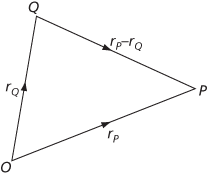Let rP and rQ be the position vectors of particles P and Q with respect to some frame of reference with origin O, as shown in the diagram. The position vector of P relative to Q is rP−rQ. If and , then vP and vQ are the velocities of P and Q relative to the frame of reference with origin O and vP−vQ is the velocity of P relative to Q. If and , then aP and aQ are the accelerations of P and Q relative to the frame of reference with origin O, and aP−aQ is the acceleration of P relative to Q. These quantities may be called the relative position, the relative velocity, and the relative acceleration of P with respect to Q.

Position of P relative to Q
These notions are important when there are two or more frames of reference, each with an associated observer.
- model-based reasoning
- model-based specification
- model checking
- modeless dialogue
- modelling
- modelling clip
- model numbers
- model organism
- model parameter
- Model Parliament
- model selection procedure
- model theory
- model validation
- modem
- modem optimizer
- mode of production
- moder
- moderated
- moderated newsgroup
- moderately repetitive DNA
- moderation
- moderator
- modern control
- modernism
- modernity